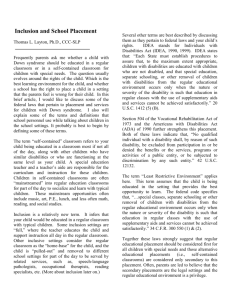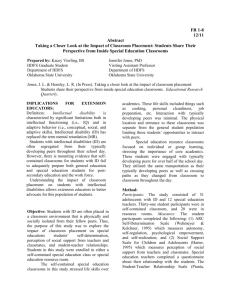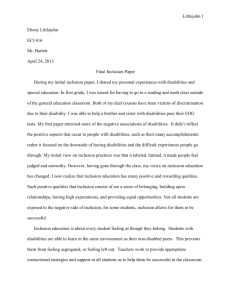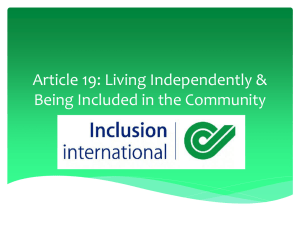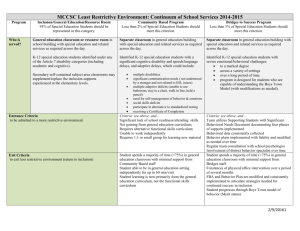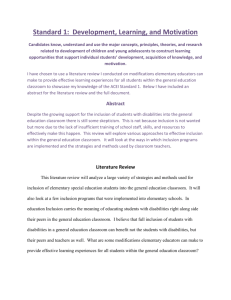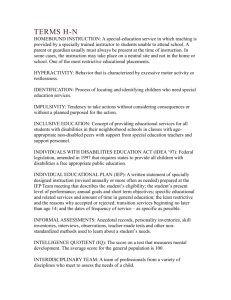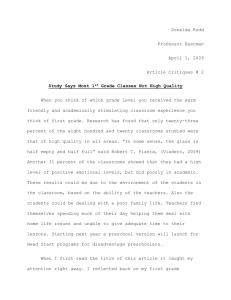Full-Inclusion - My General Education
advertisement
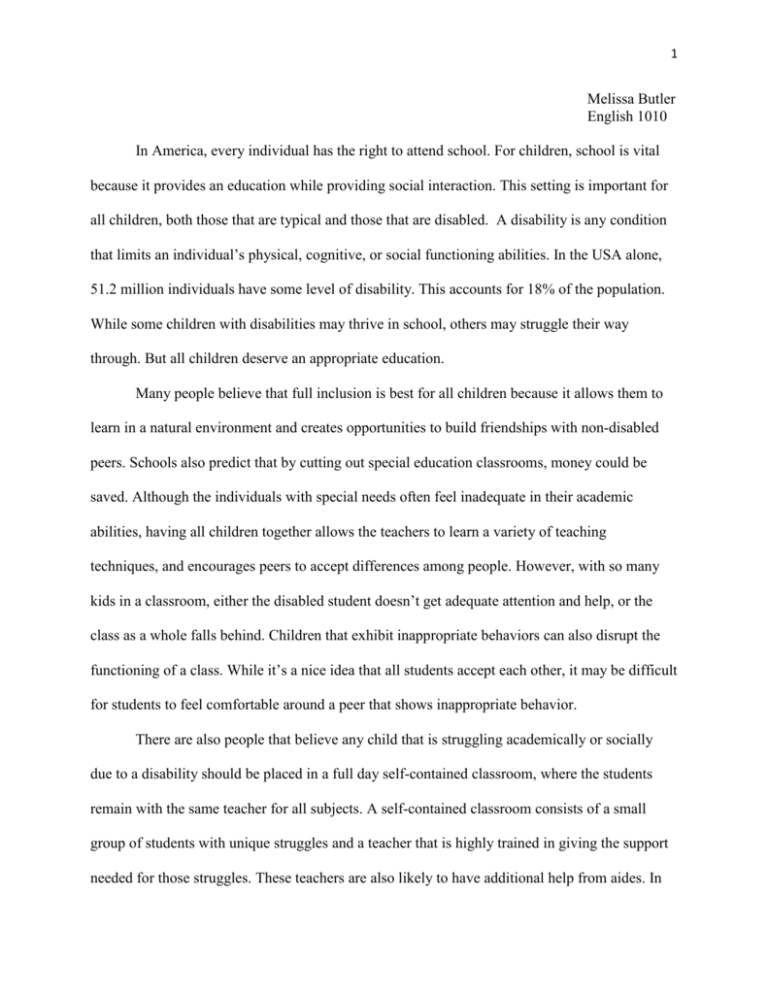
1 Melissa Butler English 1010 In America, every individual has the right to attend school. For children, school is vital because it provides an education while providing social interaction. This setting is important for all children, both those that are typical and those that are disabled. A disability is any condition that limits an individual’s physical, cognitive, or social functioning abilities. In the USA alone, 51.2 million individuals have some level of disability. This accounts for 18% of the population. While some children with disabilities may thrive in school, others may struggle their way through. But all children deserve an appropriate education. Many people believe that full inclusion is best for all children because it allows them to learn in a natural environment and creates opportunities to build friendships with non-disabled peers. Schools also predict that by cutting out special education classrooms, money could be saved. Although the individuals with special needs often feel inadequate in their academic abilities, having all children together allows the teachers to learn a variety of teaching techniques, and encourages peers to accept differences among people. However, with so many kids in a classroom, either the disabled student doesn’t get adequate attention and help, or the class as a whole falls behind. Children that exhibit inappropriate behaviors can also disrupt the functioning of a class. While it’s a nice idea that all students accept each other, it may be difficult for students to feel comfortable around a peer that shows inappropriate behavior. There are also people that believe any child that is struggling academically or socially due to a disability should be placed in a full day self-contained classroom, where the students remain with the same teacher for all subjects. A self-contained classroom consists of a small group of students with unique struggles and a teacher that is highly trained in giving the support needed for those struggles. These teachers are also likely to have additional help from aides. In 2 this setting there is a smaller student to teacher ratio, allowing one-on-one work when necessary. Also, the lesson plans are simpler than those in full inclusion classrooms and the class is able to move at a slower pace. This setting allows children with disabilities to receive extra attention, while preventing typical children from falling behind. While this setting is beneficial in many ways, it does have its drawbacks. Because the students with disabilities are in one classroom together, they don’t have many chances to interact with their non-disabled peers. Students in a self contained classroom may begin to mimic another student’s inappropriate behavior. Students may also lack the academic challenge they need in some areas because they are moving forward with the class at a lower level. People with disabilities should be in the least restrictive environment as possible. Restricting children by keeping them in self-contained classrooms is not the answer. Placing all children regardless of disability into a full inclusion setting is also not the answer. Each child with special needs should be carefully considered, placing them only in as much inclusion as is appropriate. Everyone has a desire to be liked by their peers. Although full inclusion places disabled children with their peers, friendship and acceptance aren’t guaranteed. Typical children may become frustrated with those that are disabled, and the disabled children may feel uncomfortable and embarrassed when their academic level differs. These negative feelings may create a barrier between friendships. Self contained classrooms can also prevent friendships. This segregated classroom setting doesn’t provide opportunity for typical and disabled peers to interact. A better solution would be to create a situation for social interaction without having academic comparison. Combining classes for activities such as art, music, and other elective classes would allow the children to express themselves at different levels without competition from their peers. 3 Often, children with disabilities may struggle in one academic area while excelling in another. Placing a child in a full inclusion classroom may be beneficial in some areas, while destroying an already difficult subject. But placing a child in a self-contained classroom may have the same results. Instead, children with disabilities need to be in the appropriate classroom at the appropriate time. If the student is on grade level in math, then he or she should be in the general education classroom during their math lesson. If he or she struggles in reading and writing, then they should be in the self-contained classroom during that time, receiving the attention and flexibility needed. Being in the self-contained classroom for difficult subjects would prevent other students from seeing them struggle, taking away reasons for teasing and bullying. It is no secret that school districts are tight on money. One idea that has been proposed is to save money by cutting out all self-contained classrooms, and integrating the children into full inclusion classrooms. After all, self-contained classrooms require money for extra buses, special equipment and materials, extra teachers, and space. But the truth is, no matter where these students are placed, the money will need to be spent. Placing all children into full inclusion would require that all teachers receive additional training, and that many students receive personal assistants. Special equipment and materials would also be needed in most classrooms. Since money will be needed no matter where the children are placed, each individual may as well be placed in the class that will be most beneficial in their situation. Full inclusion and self-contained classrooms can be restricting for children with disabilities. Each child should be carefully considered, and should only be placed in as much inclusion as is appropriate for their individual needs. Although all children need healthy relationships with their peers, friendships aren’t guaranteed in a certain setting or situation. 4 However, friendships can be encouraged. Teachers should encourage acceptance and social interaction between typical children and children that are disabled by combining class activities. Also, one classroom alone does not always satisfy a disabled child’s academic needs. A child with disabilities should be allowed to move between two classrooms in order to appropriately challenge their individual academic level. Funding is also a problem in the school systems today and should not be a reason to cut the support that so many children need. Special education services will need to be covered no matter where the students are located, so the students should be placed appropriately. If children with disabilities are considered individually, they will be able to reach their full potential.

